Leadership and Management in Tesco: Roles, Theories, and Environment
VerifiedAdded on 2021/02/22
|31
|3296
|43
Report
AI Summary
This report examines leadership and management within the context of Tesco, a leading retail company. It begins by defining and comparing the roles and characteristics of leaders and managers, highlighting the differences between them. The report then analyzes how leadership and management functions apply in various situational contexts, such as implementing new technologies and addressing employee turnover. Different leadership theories and models, including situational and contingency leadership, are applied to real-world scenarios. The report further explores the environmental factors impacting operational management and decision-making, assessing how these factors influence leaders and managers. The study uses examples from Tesco to illustrate the practical application of these concepts, providing a comprehensive overview of leadership and management principles within a business environment.
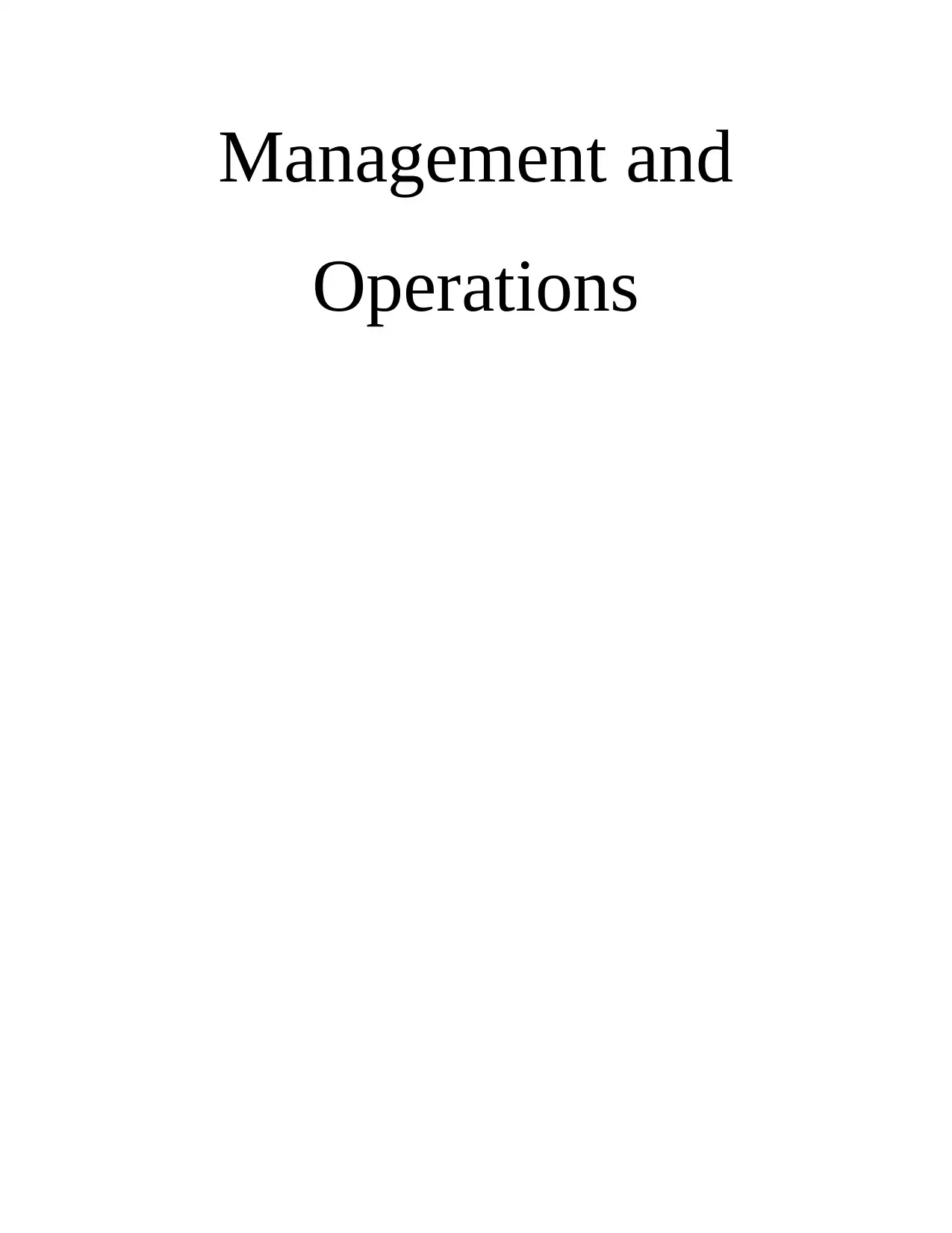
Management and
Operations
Operations
Paraphrase This Document
Need a fresh take? Get an instant paraphrase of this document with our AI Paraphraser
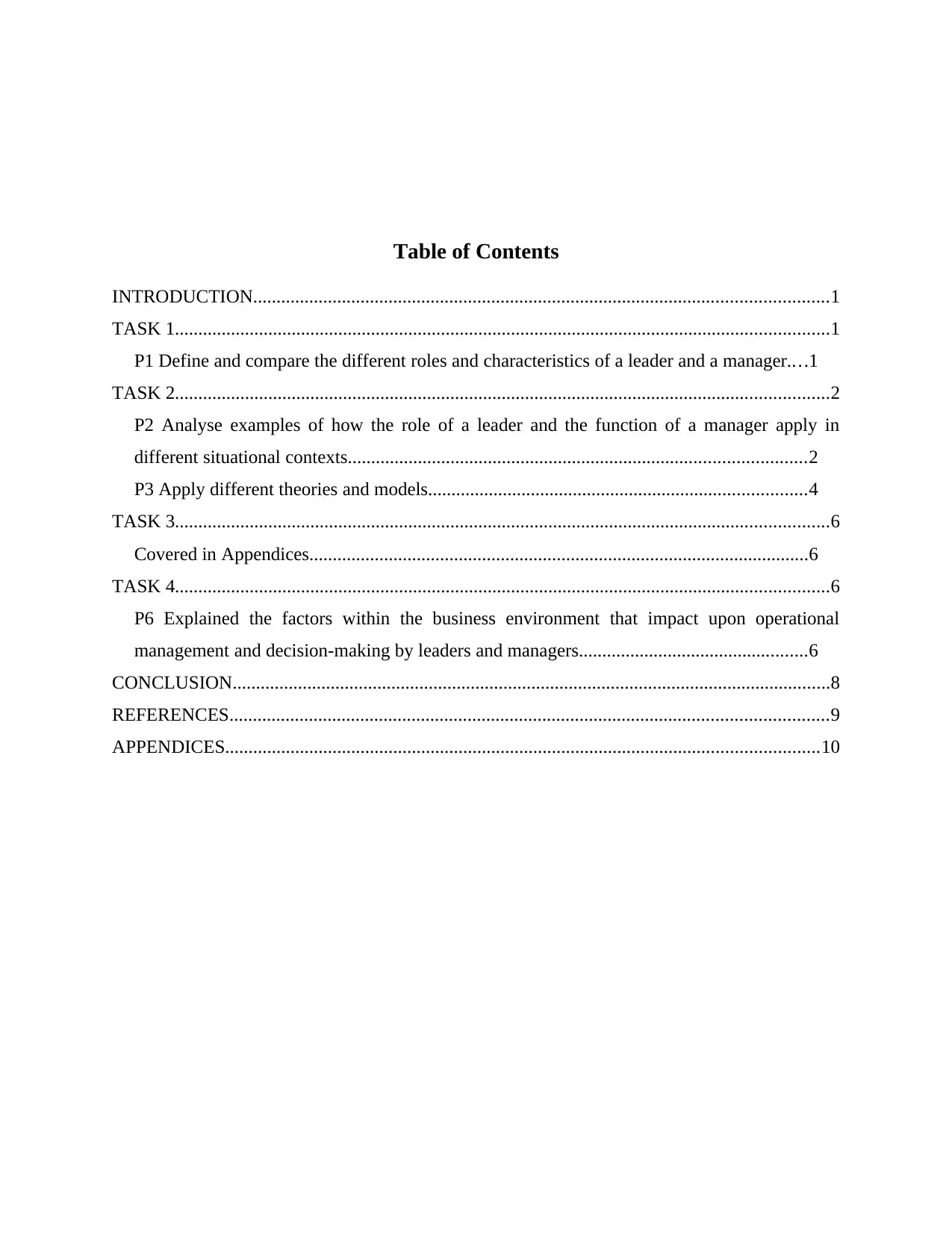
Table of Contents
INTRODUCTION...........................................................................................................................1
TASK 1............................................................................................................................................1
P1 Define and compare the different roles and characteristics of a leader and a manager....1
TASK 2............................................................................................................................................2
P2 Analyse examples of how the role of a leader and the function of a manager apply in
different situational contexts..................................................................................................2
P3 Apply different theories and models.................................................................................4
TASK 3............................................................................................................................................6
Covered in Appendices...........................................................................................................6
TASK 4............................................................................................................................................6
P6 Explained the factors within the business environment that impact upon operational
management and decision-making by leaders and managers.................................................6
CONCLUSION................................................................................................................................8
REFERENCES................................................................................................................................9
APPENDICES...............................................................................................................................10
INTRODUCTION...........................................................................................................................1
TASK 1............................................................................................................................................1
P1 Define and compare the different roles and characteristics of a leader and a manager....1
TASK 2............................................................................................................................................2
P2 Analyse examples of how the role of a leader and the function of a manager apply in
different situational contexts..................................................................................................2
P3 Apply different theories and models.................................................................................4
TASK 3............................................................................................................................................6
Covered in Appendices...........................................................................................................6
TASK 4............................................................................................................................................6
P6 Explained the factors within the business environment that impact upon operational
management and decision-making by leaders and managers.................................................6
CONCLUSION................................................................................................................................8
REFERENCES................................................................................................................................9
APPENDICES...............................................................................................................................10
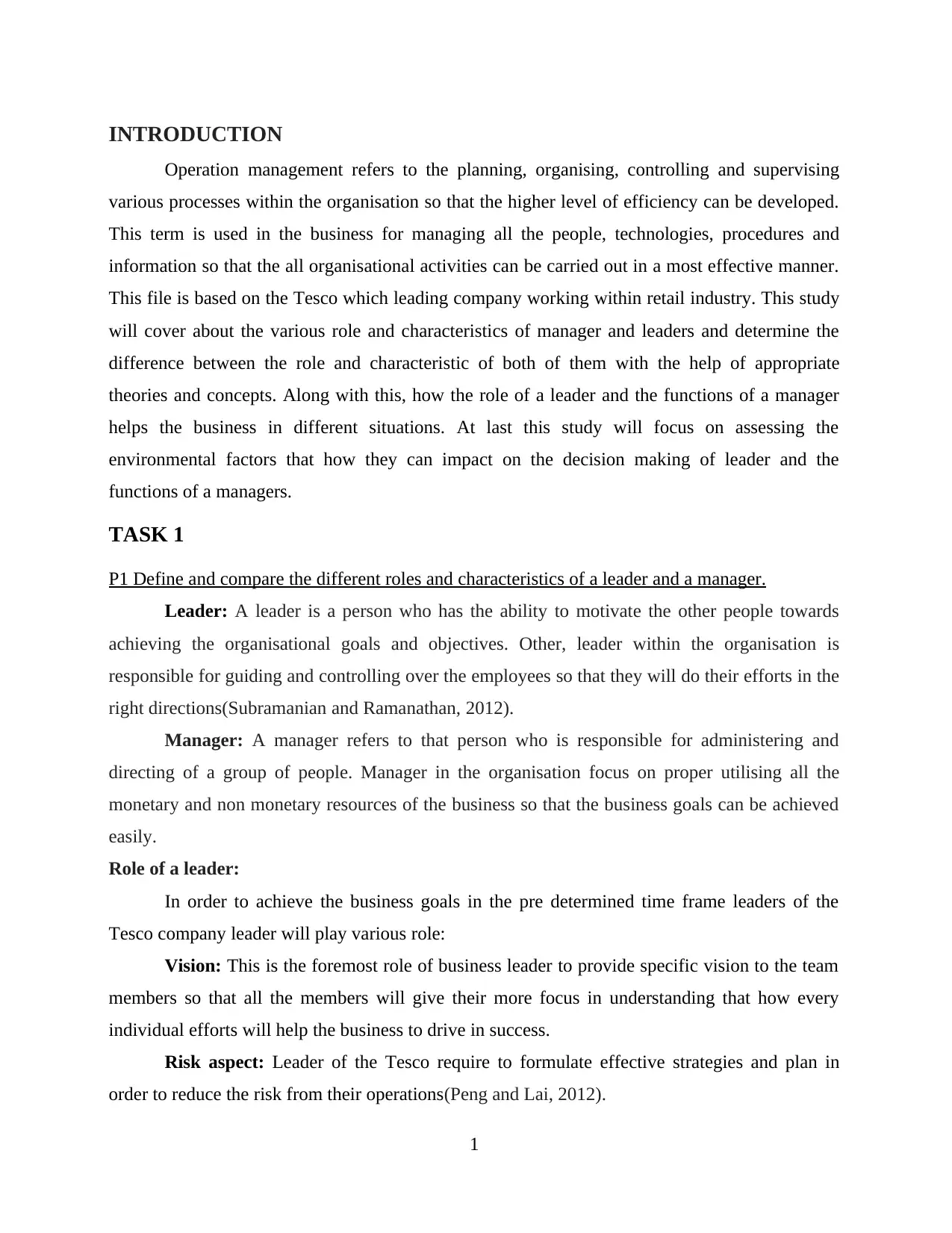
INTRODUCTION
Operation management refers to the planning, organising, controlling and supervising
various processes within the organisation so that the higher level of efficiency can be developed.
This term is used in the business for managing all the people, technologies, procedures and
information so that the all organisational activities can be carried out in a most effective manner.
This file is based on the Tesco which leading company working within retail industry. This study
will cover about the various role and characteristics of manager and leaders and determine the
difference between the role and characteristic of both of them with the help of appropriate
theories and concepts. Along with this, how the role of a leader and the functions of a manager
helps the business in different situations. At last this study will focus on assessing the
environmental factors that how they can impact on the decision making of leader and the
functions of a managers.
TASK 1
P1 Define and compare the different roles and characteristics of a leader and a manager.
Leader: A leader is a person who has the ability to motivate the other people towards
achieving the organisational goals and objectives. Other, leader within the organisation is
responsible for guiding and controlling over the employees so that they will do their efforts in the
right directions(Subramanian and Ramanathan, 2012).
Manager: A manager refers to that person who is responsible for administering and
directing of a group of people. Manager in the organisation focus on proper utilising all the
monetary and non monetary resources of the business so that the business goals can be achieved
easily.
Role of a leader:
In order to achieve the business goals in the pre determined time frame leaders of the
Tesco company leader will play various role:
Vision: This is the foremost role of business leader to provide specific vision to the team
members so that all the members will give their more focus in understanding that how every
individual efforts will help the business to drive in success.
Risk aspect: Leader of the Tesco require to formulate effective strategies and plan in
order to reduce the risk from their operations(Peng and Lai, 2012).
1
Operation management refers to the planning, organising, controlling and supervising
various processes within the organisation so that the higher level of efficiency can be developed.
This term is used in the business for managing all the people, technologies, procedures and
information so that the all organisational activities can be carried out in a most effective manner.
This file is based on the Tesco which leading company working within retail industry. This study
will cover about the various role and characteristics of manager and leaders and determine the
difference between the role and characteristic of both of them with the help of appropriate
theories and concepts. Along with this, how the role of a leader and the functions of a manager
helps the business in different situations. At last this study will focus on assessing the
environmental factors that how they can impact on the decision making of leader and the
functions of a managers.
TASK 1
P1 Define and compare the different roles and characteristics of a leader and a manager.
Leader: A leader is a person who has the ability to motivate the other people towards
achieving the organisational goals and objectives. Other, leader within the organisation is
responsible for guiding and controlling over the employees so that they will do their efforts in the
right directions(Subramanian and Ramanathan, 2012).
Manager: A manager refers to that person who is responsible for administering and
directing of a group of people. Manager in the organisation focus on proper utilising all the
monetary and non monetary resources of the business so that the business goals can be achieved
easily.
Role of a leader:
In order to achieve the business goals in the pre determined time frame leaders of the
Tesco company leader will play various role:
Vision: This is the foremost role of business leader to provide specific vision to the team
members so that all the members will give their more focus in understanding that how every
individual efforts will help the business to drive in success.
Risk aspect: Leader of the Tesco require to formulate effective strategies and plan in
order to reduce the risk from their operations(Peng and Lai, 2012).
1
⊘ This is a preview!⊘
Do you want full access?
Subscribe today to unlock all pages.

Trusted by 1+ million students worldwide

Role of a manager:
Manager in the organisation perform various function within the organisation in which
manager have an important role:
Directions: In this role, manager will seek out the information related to the directing the
employees activities and looking for required changes so that the employees can accomplish their
work with great efficiency and appropriately(Galindo and Batta, 2013).
Systems and process: The manager of Tesco business needs to evaluate their process so
that the necessary changes can be implemented and the efficiency and success of the business can
be assured.
Characteristics of a leader:
Confidence: A leader is always confident for their decisions as they does not need to
communicate with other higher management due to which they can easily guide and motivate
their employees to complete their work with great efficiency.
Delegation: Leaders always concern for guiding and motivating their employees for
accomplishing their work effectively rather than the delegation of the authority(Song and Parola,
2015).
Characteristics of a manager:
Communication: An effective manager requires to communicate with their team
members effectively not only related to their responsibilities and expectations but also they
should focus on listening their team and corporate them so that they can come up with the best
outcomes.
Reliability: The manager of Tesco business must be reliable within the organisation as
reliability refers to the availability of the manager for their employees so that they can perform
their task in a most significant manner.
TASK 2
P2 Analyse examples of how the role of a leader and the function of a manager apply in different
situational contexts.
In any organisation leader and managers have their important role as because the success
of the business depends on the effective leadership and management. As a single leadership or
managerial approach is not suitable in every situation due to this the managers and leaders needs
2
Manager in the organisation perform various function within the organisation in which
manager have an important role:
Directions: In this role, manager will seek out the information related to the directing the
employees activities and looking for required changes so that the employees can accomplish their
work with great efficiency and appropriately(Galindo and Batta, 2013).
Systems and process: The manager of Tesco business needs to evaluate their process so
that the necessary changes can be implemented and the efficiency and success of the business can
be assured.
Characteristics of a leader:
Confidence: A leader is always confident for their decisions as they does not need to
communicate with other higher management due to which they can easily guide and motivate
their employees to complete their work with great efficiency.
Delegation: Leaders always concern for guiding and motivating their employees for
accomplishing their work effectively rather than the delegation of the authority(Song and Parola,
2015).
Characteristics of a manager:
Communication: An effective manager requires to communicate with their team
members effectively not only related to their responsibilities and expectations but also they
should focus on listening their team and corporate them so that they can come up with the best
outcomes.
Reliability: The manager of Tesco business must be reliable within the organisation as
reliability refers to the availability of the manager for their employees so that they can perform
their task in a most significant manner.
TASK 2
P2 Analyse examples of how the role of a leader and the function of a manager apply in different
situational contexts.
In any organisation leader and managers have their important role as because the success
of the business depends on the effective leadership and management. As a single leadership or
managerial approach is not suitable in every situation due to this the managers and leaders needs
2
Paraphrase This Document
Need a fresh take? Get an instant paraphrase of this document with our AI Paraphraser
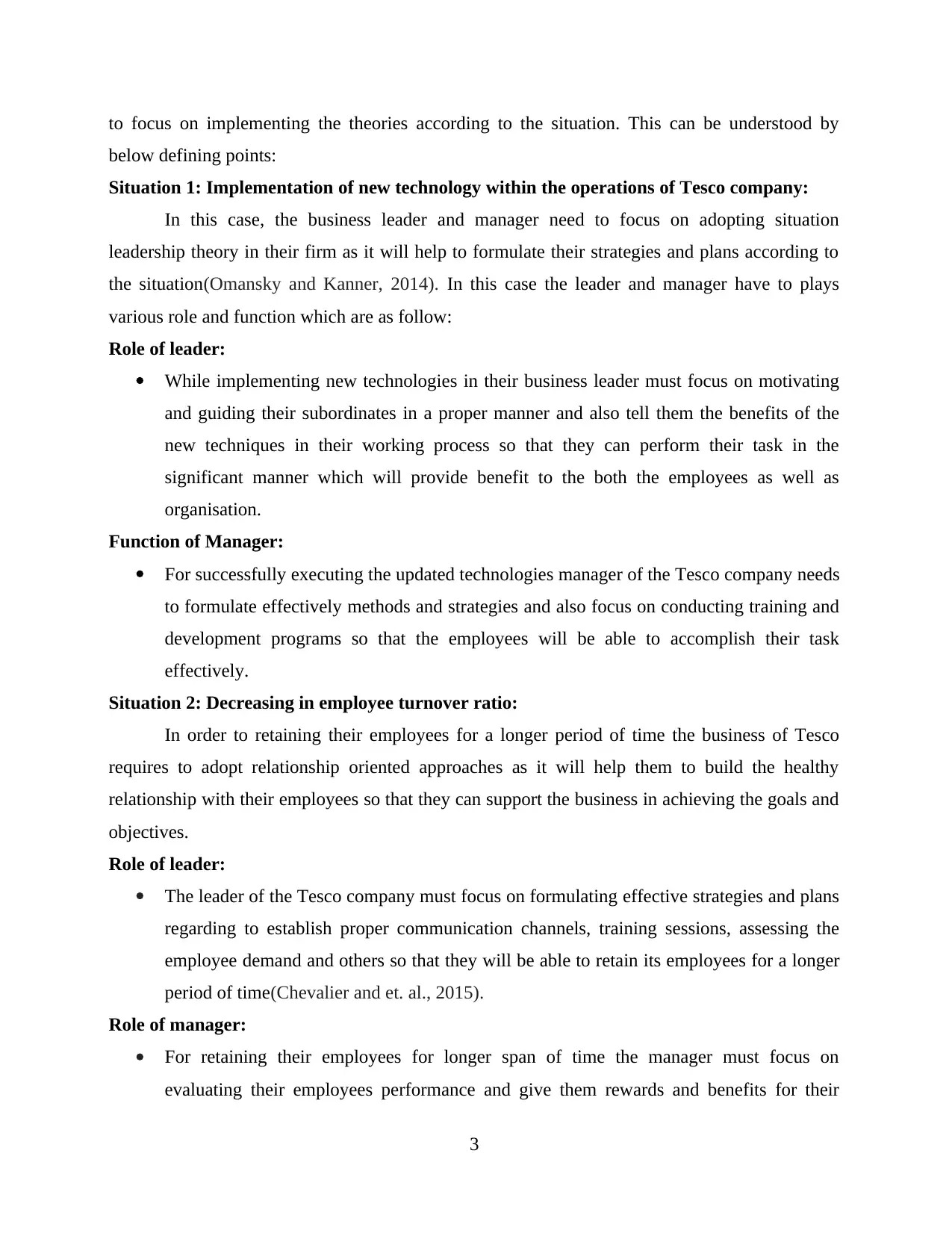
to focus on implementing the theories according to the situation. This can be understood by
below defining points:
Situation 1: Implementation of new technology within the operations of Tesco company:
In this case, the business leader and manager need to focus on adopting situation
leadership theory in their firm as it will help to formulate their strategies and plans according to
the situation(Omansky and Kanner, 2014). In this case the leader and manager have to plays
various role and function which are as follow:
Role of leader:
While implementing new technologies in their business leader must focus on motivating
and guiding their subordinates in a proper manner and also tell them the benefits of the
new techniques in their working process so that they can perform their task in the
significant manner which will provide benefit to the both the employees as well as
organisation.
Function of Manager:
For successfully executing the updated technologies manager of the Tesco company needs
to formulate effectively methods and strategies and also focus on conducting training and
development programs so that the employees will be able to accomplish their task
effectively.
Situation 2: Decreasing in employee turnover ratio:
In order to retaining their employees for a longer period of time the business of Tesco
requires to adopt relationship oriented approaches as it will help them to build the healthy
relationship with their employees so that they can support the business in achieving the goals and
objectives.
Role of leader:
The leader of the Tesco company must focus on formulating effective strategies and plans
regarding to establish proper communication channels, training sessions, assessing the
employee demand and others so that they will be able to retain its employees for a longer
period of time(Chevalier and et. al., 2015).
Role of manager:
For retaining their employees for longer span of time the manager must focus on
evaluating their employees performance and give them rewards and benefits for their
3
below defining points:
Situation 1: Implementation of new technology within the operations of Tesco company:
In this case, the business leader and manager need to focus on adopting situation
leadership theory in their firm as it will help to formulate their strategies and plans according to
the situation(Omansky and Kanner, 2014). In this case the leader and manager have to plays
various role and function which are as follow:
Role of leader:
While implementing new technologies in their business leader must focus on motivating
and guiding their subordinates in a proper manner and also tell them the benefits of the
new techniques in their working process so that they can perform their task in the
significant manner which will provide benefit to the both the employees as well as
organisation.
Function of Manager:
For successfully executing the updated technologies manager of the Tesco company needs
to formulate effectively methods and strategies and also focus on conducting training and
development programs so that the employees will be able to accomplish their task
effectively.
Situation 2: Decreasing in employee turnover ratio:
In order to retaining their employees for a longer period of time the business of Tesco
requires to adopt relationship oriented approaches as it will help them to build the healthy
relationship with their employees so that they can support the business in achieving the goals and
objectives.
Role of leader:
The leader of the Tesco company must focus on formulating effective strategies and plans
regarding to establish proper communication channels, training sessions, assessing the
employee demand and others so that they will be able to retain its employees for a longer
period of time(Chevalier and et. al., 2015).
Role of manager:
For retaining their employees for longer span of time the manager must focus on
evaluating their employees performance and give them rewards and benefits for their
3

higher efforts. This will direct positive impact on the employees which will provide
success to the organisation(Fu and Wnuk, 2015).
Hence, from the above discussion it can be stated that in order to attain higher success and
growth manager and leaders needs to execute their various functions and roles according to the
situation so that they will be able to overcome from the negative impact of the situations easily.
P3 Apply different theories and models
The leaders of the Tesco business must give their focus on adopting various leadership
approaches according to their business requirements or situations so that they can get higher
success and growth in the organisation. Here are define some of the effective leadership theories:
Situational leadership theory : This theory of leadership mainly focussed on the
adopting that leadership style which is perfect as per the situation. As per this theory the most
suitable leaders is one who leads the situation that has occur automatically. This theory helps the
business organisation to cope up from all the negative situations within the organisation.
History of situational leadership theory: This theory has formed by Blanchard and
Hersey in 1969, after sometime this theory is known as “Life cycle theory of the leadership”. In
the year of 1970 this theory was again figured as the situational theory of leadership.
Example of situational leadership : For better understanding this theory lets consider a
situation. In an organisation is facing the issue of lack of knowledge and experience in their
employees then in this case the leader needs to focus on providing effective training and
development programs to their employees so that they can knowledge, abilities and talent of them
can be increased. But in this aspect the leader must consider each and every individual situation
that in which an employees is lacking so that the necessary and effective training can be provided
to them which enables them to deal with the situation effectively.
Situational theory quotation:
According to Margaret wheatley, Leadership depicts to the series of behaviour rather than role
of heroes.
According to Colin Powell, Leadership is solving issues.
Characteristics of situational leadership theory :
Insight: This characteristic is most crucial in the situational leadership as it allows the
leaders to understand their followers and make adjustment accordingly so that the requirements
of their can be fulfilled.
4
success to the organisation(Fu and Wnuk, 2015).
Hence, from the above discussion it can be stated that in order to attain higher success and
growth manager and leaders needs to execute their various functions and roles according to the
situation so that they will be able to overcome from the negative impact of the situations easily.
P3 Apply different theories and models
The leaders of the Tesco business must give their focus on adopting various leadership
approaches according to their business requirements or situations so that they can get higher
success and growth in the organisation. Here are define some of the effective leadership theories:
Situational leadership theory : This theory of leadership mainly focussed on the
adopting that leadership style which is perfect as per the situation. As per this theory the most
suitable leaders is one who leads the situation that has occur automatically. This theory helps the
business organisation to cope up from all the negative situations within the organisation.
History of situational leadership theory: This theory has formed by Blanchard and
Hersey in 1969, after sometime this theory is known as “Life cycle theory of the leadership”. In
the year of 1970 this theory was again figured as the situational theory of leadership.
Example of situational leadership : For better understanding this theory lets consider a
situation. In an organisation is facing the issue of lack of knowledge and experience in their
employees then in this case the leader needs to focus on providing effective training and
development programs to their employees so that they can knowledge, abilities and talent of them
can be increased. But in this aspect the leader must consider each and every individual situation
that in which an employees is lacking so that the necessary and effective training can be provided
to them which enables them to deal with the situation effectively.
Situational theory quotation:
According to Margaret wheatley, Leadership depicts to the series of behaviour rather than role
of heroes.
According to Colin Powell, Leadership is solving issues.
Characteristics of situational leadership theory :
Insight: This characteristic is most crucial in the situational leadership as it allows the
leaders to understand their followers and make adjustment accordingly so that the requirements
of their can be fulfilled.
4
⊘ This is a preview!⊘
Do you want full access?
Subscribe today to unlock all pages.

Trusted by 1+ million students worldwide
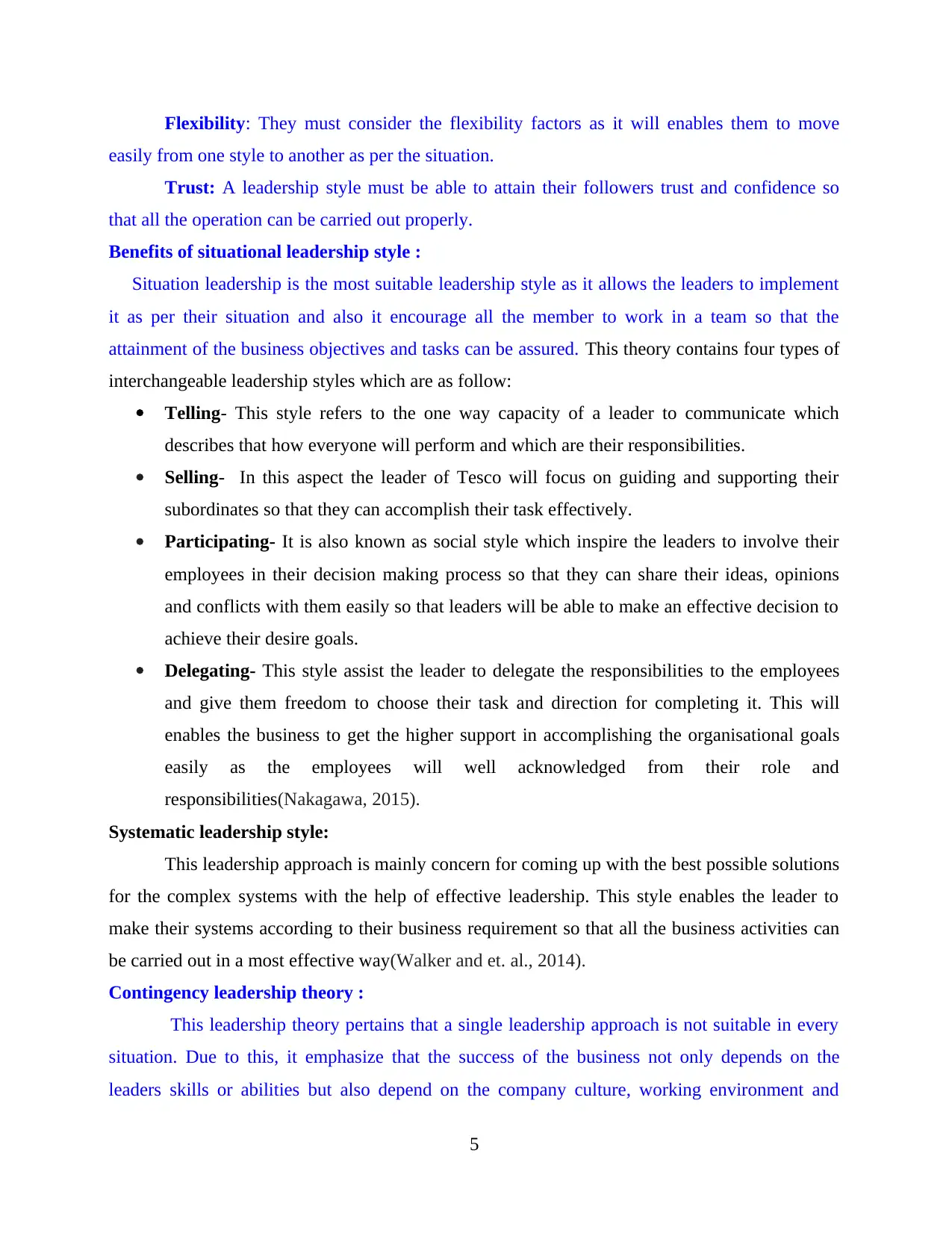
Flexibility: They must consider the flexibility factors as it will enables them to move
easily from one style to another as per the situation.
Trust: A leadership style must be able to attain their followers trust and confidence so
that all the operation can be carried out properly.
Benefits of situational leadership style :
Situation leadership is the most suitable leadership style as it allows the leaders to implement
it as per their situation and also it encourage all the member to work in a team so that the
attainment of the business objectives and tasks can be assured. This theory contains four types of
interchangeable leadership styles which are as follow:
Telling- This style refers to the one way capacity of a leader to communicate which
describes that how everyone will perform and which are their responsibilities.
Selling- In this aspect the leader of Tesco will focus on guiding and supporting their
subordinates so that they can accomplish their task effectively.
Participating- It is also known as social style which inspire the leaders to involve their
employees in their decision making process so that they can share their ideas, opinions
and conflicts with them easily so that leaders will be able to make an effective decision to
achieve their desire goals.
Delegating- This style assist the leader to delegate the responsibilities to the employees
and give them freedom to choose their task and direction for completing it. This will
enables the business to get the higher support in accomplishing the organisational goals
easily as the employees will well acknowledged from their role and
responsibilities(Nakagawa, 2015).
Systematic leadership style:
This leadership approach is mainly concern for coming up with the best possible solutions
for the complex systems with the help of effective leadership. This style enables the leader to
make their systems according to their business requirement so that all the business activities can
be carried out in a most effective way(Walker and et. al., 2014).
Contingency leadership theory :
This leadership theory pertains that a single leadership approach is not suitable in every
situation. Due to this, it emphasize that the success of the business not only depends on the
leaders skills or abilities but also depend on the company culture, working environment and
5
easily from one style to another as per the situation.
Trust: A leadership style must be able to attain their followers trust and confidence so
that all the operation can be carried out properly.
Benefits of situational leadership style :
Situation leadership is the most suitable leadership style as it allows the leaders to implement
it as per their situation and also it encourage all the member to work in a team so that the
attainment of the business objectives and tasks can be assured. This theory contains four types of
interchangeable leadership styles which are as follow:
Telling- This style refers to the one way capacity of a leader to communicate which
describes that how everyone will perform and which are their responsibilities.
Selling- In this aspect the leader of Tesco will focus on guiding and supporting their
subordinates so that they can accomplish their task effectively.
Participating- It is also known as social style which inspire the leaders to involve their
employees in their decision making process so that they can share their ideas, opinions
and conflicts with them easily so that leaders will be able to make an effective decision to
achieve their desire goals.
Delegating- This style assist the leader to delegate the responsibilities to the employees
and give them freedom to choose their task and direction for completing it. This will
enables the business to get the higher support in accomplishing the organisational goals
easily as the employees will well acknowledged from their role and
responsibilities(Nakagawa, 2015).
Systematic leadership style:
This leadership approach is mainly concern for coming up with the best possible solutions
for the complex systems with the help of effective leadership. This style enables the leader to
make their systems according to their business requirement so that all the business activities can
be carried out in a most effective way(Walker and et. al., 2014).
Contingency leadership theory :
This leadership theory pertains that a single leadership approach is not suitable in every
situation. Due to this, it emphasize that the success of the business not only depends on the
leaders skills or abilities but also depend on the company culture, working environment and
5
Paraphrase This Document
Need a fresh take? Get an instant paraphrase of this document with our AI Paraphraser

employees. So it is essential for the leader of the Tesco to give their focus on the all aspects of the
business in order to attain success and growth in the business.
History of contingency theory:
This leadership theory has been developed in the year of 1958. Fred fielder believed that
the leaders get success by considering the two factors which includes control of the particular
situation and manager's set of skills. This theory has been formed after considering that the ability
or the skills of the leaders remain fixed but the situations keeps on changing position.
How does it works:
This is advisable that the contingency theory is only suitable when the leaders is able to
properly scan the situation and adopt the best leadership style as per the situation. This theory
does not work on basis of that if a theory which they have adopted in their past will get success in
the present time also.
Fiedler's contingency theory:
This leadership theory is considered a best theory of the leadership as the main focus of
this theory on assessing that how much leadership style which have adopted by the organisation
matched to the situation. Fielder's contingency theory was given by the Fred fielders who
considered that the leaders falls into the one or situations which can be task oriented and people
oriented. This theory also given their focus on maintaining the proper authenticity in the leader
and their relationship with their followers.
TASK 3
Covered in Appendices
TASK 4
P6 Explained the factors within the business environment that impact upon operational
management and decision-making by leaders and managers.
In the business organisation various factors are available inside the business or outside the
organisation which have great impact on the decision-making and operation management of the
business. All these internal and external factors can impact the business in an effective manner
which are described below:
Internal factors:
6
business in order to attain success and growth in the business.
History of contingency theory:
This leadership theory has been developed in the year of 1958. Fred fielder believed that
the leaders get success by considering the two factors which includes control of the particular
situation and manager's set of skills. This theory has been formed after considering that the ability
or the skills of the leaders remain fixed but the situations keeps on changing position.
How does it works:
This is advisable that the contingency theory is only suitable when the leaders is able to
properly scan the situation and adopt the best leadership style as per the situation. This theory
does not work on basis of that if a theory which they have adopted in their past will get success in
the present time also.
Fiedler's contingency theory:
This leadership theory is considered a best theory of the leadership as the main focus of
this theory on assessing that how much leadership style which have adopted by the organisation
matched to the situation. Fielder's contingency theory was given by the Fred fielders who
considered that the leaders falls into the one or situations which can be task oriented and people
oriented. This theory also given their focus on maintaining the proper authenticity in the leader
and their relationship with their followers.
TASK 3
Covered in Appendices
TASK 4
P6 Explained the factors within the business environment that impact upon operational
management and decision-making by leaders and managers.
In the business organisation various factors are available inside the business or outside the
organisation which have great impact on the decision-making and operation management of the
business. All these internal and external factors can impact the business in an effective manner
which are described below:
Internal factors:
6

Ethics: The managers and leaders within the Tesco organisation needs to regulate all their
operations in an ethical manner so that the employees trust and organisation reputation can be
maintained. For this, the they should take effective decisions related to provide fair treatment and
positive working environment to their employees.
Culture: In order to operate all the business activities significantly manager and leaders
needs to focus on adopting corporate culture within the organisation which reflect that how
employee and management is handling outside business transactions(Ageron, Gunasekaran and
Spalanzani, 2012).
Internal environment:
For analysing the impact of outside environment Tesco company can adopt the PESTLE
analysis which is explained beneath:
Political factors: These factors are related to the government rules and regulations like
tax policy, labour law, trade policy etc. All these have great impact on the business for example,
if the government will loose the free trade policy then the Tesco company can easily purchase
and sale their products in another nation.
Economic factors: These factors includes interest rate, inflation rate, economic growth
and others elements. The impact of this factor on the business can be understood by this example,
if the inflation rate will be increase in the economic then it will direct impact on the buying
behaviour of the customers which will decrease the overall sales of the business.
Social factors: This assist the Tesco that they should produce their products and services
according to the customers demand so that they can prevent from the negative impact of this
factor.
Technological: For sustaining in the marketplace Tesco needs to use update technologies
in their production so that they can produce their products as per the current market trends and
can increase their overall profitability(SSinghal and Singhal, 2012).
Environment factor: The business manager of Crous requires to consider all the
environmental factor in their processes so that the overall brand value of the business can be
increased.
Legal factors: In order to operate the business activities without any crisis business
manager of Tesco must consider all the legal rules and regulations in their business. For example,
they should follow the equal opportunity law in their business so that every employees will be
7
operations in an ethical manner so that the employees trust and organisation reputation can be
maintained. For this, the they should take effective decisions related to provide fair treatment and
positive working environment to their employees.
Culture: In order to operate all the business activities significantly manager and leaders
needs to focus on adopting corporate culture within the organisation which reflect that how
employee and management is handling outside business transactions(Ageron, Gunasekaran and
Spalanzani, 2012).
Internal environment:
For analysing the impact of outside environment Tesco company can adopt the PESTLE
analysis which is explained beneath:
Political factors: These factors are related to the government rules and regulations like
tax policy, labour law, trade policy etc. All these have great impact on the business for example,
if the government will loose the free trade policy then the Tesco company can easily purchase
and sale their products in another nation.
Economic factors: These factors includes interest rate, inflation rate, economic growth
and others elements. The impact of this factor on the business can be understood by this example,
if the inflation rate will be increase in the economic then it will direct impact on the buying
behaviour of the customers which will decrease the overall sales of the business.
Social factors: This assist the Tesco that they should produce their products and services
according to the customers demand so that they can prevent from the negative impact of this
factor.
Technological: For sustaining in the marketplace Tesco needs to use update technologies
in their production so that they can produce their products as per the current market trends and
can increase their overall profitability(SSinghal and Singhal, 2012).
Environment factor: The business manager of Crous requires to consider all the
environmental factor in their processes so that the overall brand value of the business can be
increased.
Legal factors: In order to operate the business activities without any crisis business
manager of Tesco must consider all the legal rules and regulations in their business. For example,
they should follow the equal opportunity law in their business so that every employees will be
7
⊘ This is a preview!⊘
Do you want full access?
Subscribe today to unlock all pages.

Trusted by 1+ million students worldwide
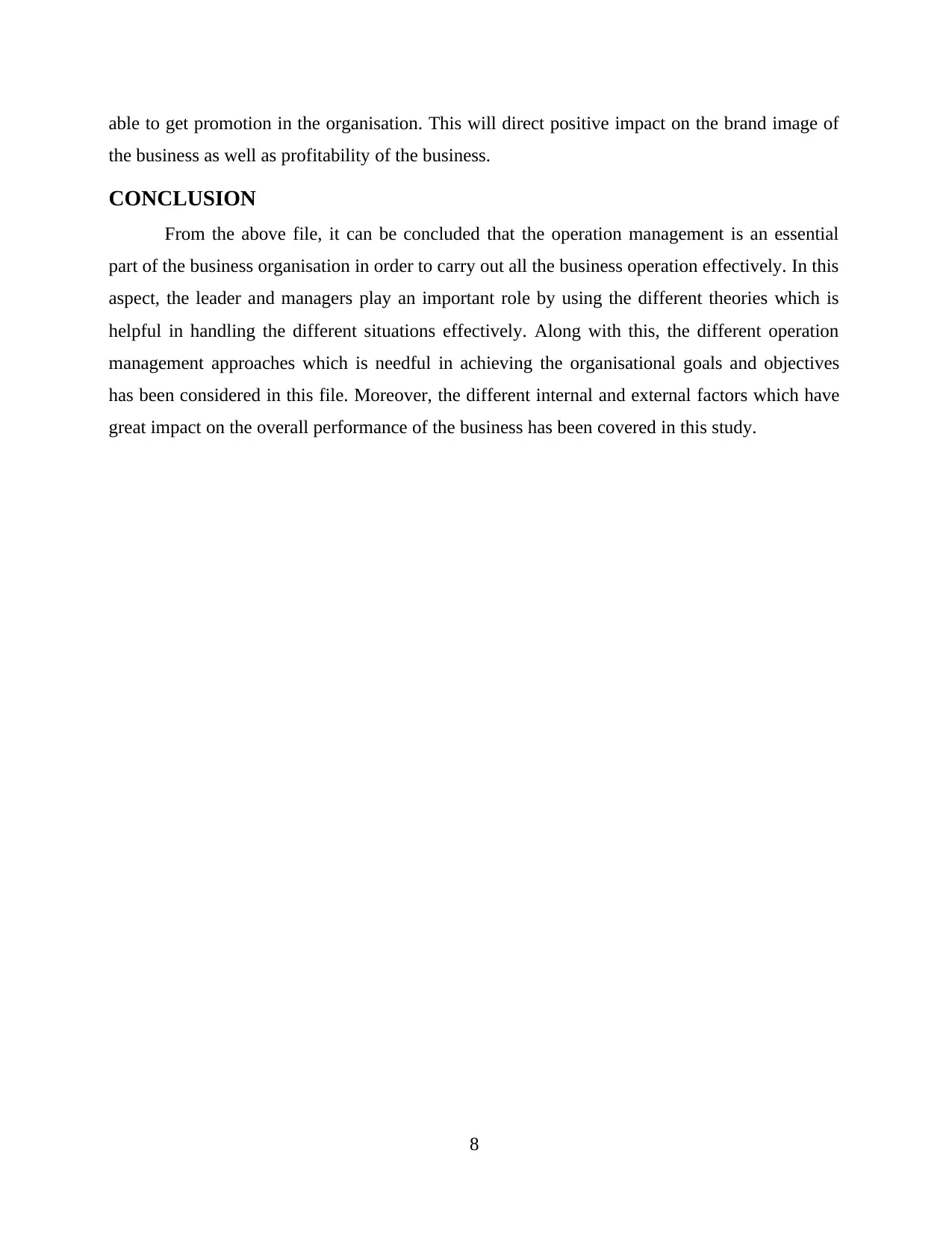
able to get promotion in the organisation. This will direct positive impact on the brand image of
the business as well as profitability of the business.
CONCLUSION
From the above file, it can be concluded that the operation management is an essential
part of the business organisation in order to carry out all the business operation effectively. In this
aspect, the leader and managers play an important role by using the different theories which is
helpful in handling the different situations effectively. Along with this, the different operation
management approaches which is needful in achieving the organisational goals and objectives
has been considered in this file. Moreover, the different internal and external factors which have
great impact on the overall performance of the business has been covered in this study.
8
the business as well as profitability of the business.
CONCLUSION
From the above file, it can be concluded that the operation management is an essential
part of the business organisation in order to carry out all the business operation effectively. In this
aspect, the leader and managers play an important role by using the different theories which is
helpful in handling the different situations effectively. Along with this, the different operation
management approaches which is needful in achieving the organisational goals and objectives
has been considered in this file. Moreover, the different internal and external factors which have
great impact on the overall performance of the business has been covered in this study.
8
Paraphrase This Document
Need a fresh take? Get an instant paraphrase of this document with our AI Paraphraser
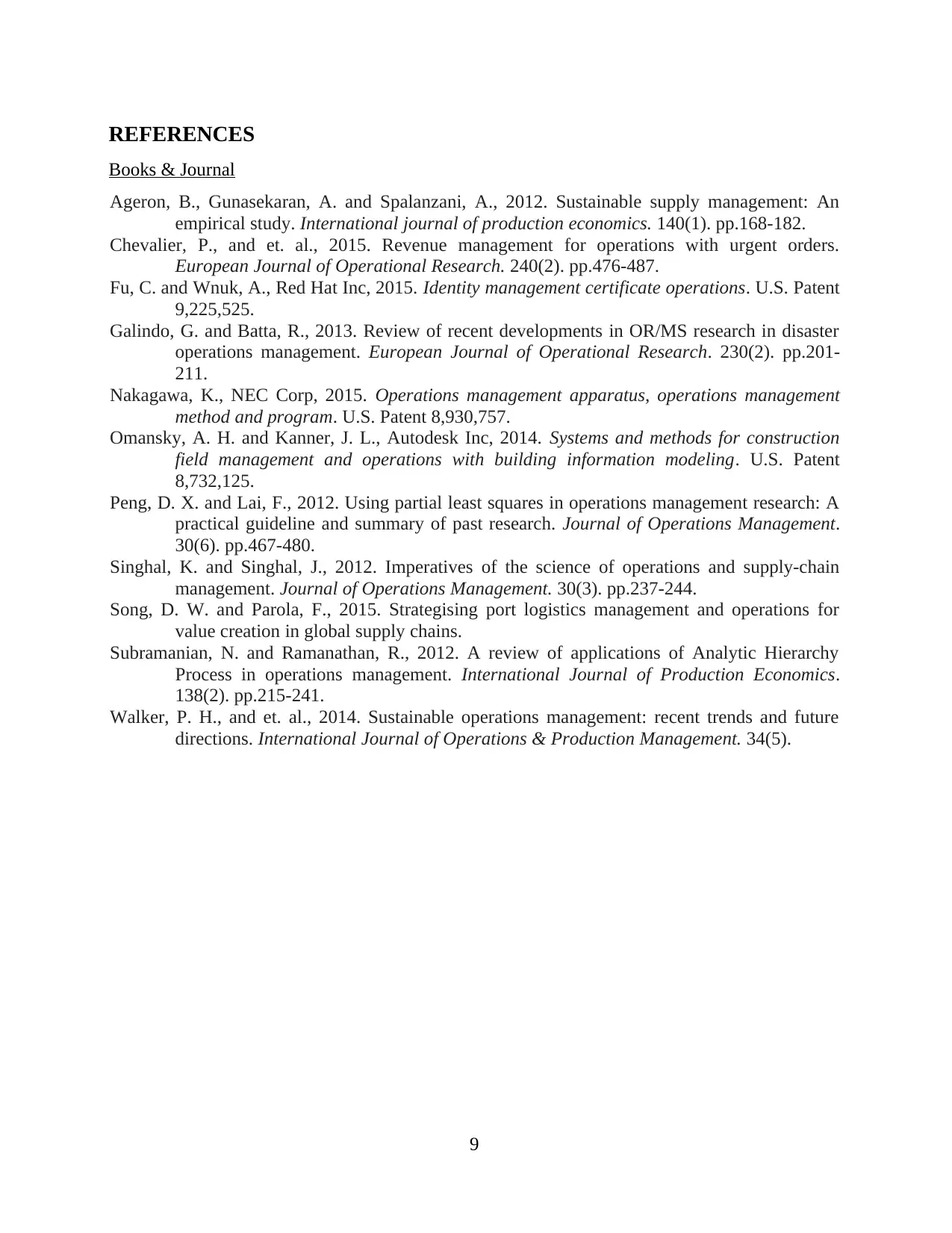
REFERENCES
Books & Journal
Ageron, B., Gunasekaran, A. and Spalanzani, A., 2012. Sustainable supply management: An
empirical study. International journal of production economics. 140(1). pp.168-182.
Chevalier, P., and et. al., 2015. Revenue management for operations with urgent orders.
European Journal of Operational Research. 240(2). pp.476-487.
Fu, C. and Wnuk, A., Red Hat Inc, 2015. Identity management certificate operations. U.S. Patent
9,225,525.
Galindo, G. and Batta, R., 2013. Review of recent developments in OR/MS research in disaster
operations management. European Journal of Operational Research. 230(2). pp.201-
211.
Nakagawa, K., NEC Corp, 2015. Operations management apparatus, operations management
method and program. U.S. Patent 8,930,757.
Omansky, A. H. and Kanner, J. L., Autodesk Inc, 2014. Systems and methods for construction
field management and operations with building information modeling. U.S. Patent
8,732,125.
Peng, D. X. and Lai, F., 2012. Using partial least squares in operations management research: A
practical guideline and summary of past research. Journal of Operations Management.
30(6). pp.467-480.
Singhal, K. and Singhal, J., 2012. Imperatives of the science of operations and supply-chain
management. Journal of Operations Management. 30(3). pp.237-244.
Song, D. W. and Parola, F., 2015. Strategising port logistics management and operations for
value creation in global supply chains.
Subramanian, N. and Ramanathan, R., 2012. A review of applications of Analytic Hierarchy
Process in operations management. International Journal of Production Economics.
138(2). pp.215-241.
Walker, P. H., and et. al., 2014. Sustainable operations management: recent trends and future
directions. International Journal of Operations & Production Management. 34(5).
9
Books & Journal
Ageron, B., Gunasekaran, A. and Spalanzani, A., 2012. Sustainable supply management: An
empirical study. International journal of production economics. 140(1). pp.168-182.
Chevalier, P., and et. al., 2015. Revenue management for operations with urgent orders.
European Journal of Operational Research. 240(2). pp.476-487.
Fu, C. and Wnuk, A., Red Hat Inc, 2015. Identity management certificate operations. U.S. Patent
9,225,525.
Galindo, G. and Batta, R., 2013. Review of recent developments in OR/MS research in disaster
operations management. European Journal of Operational Research. 230(2). pp.201-
211.
Nakagawa, K., NEC Corp, 2015. Operations management apparatus, operations management
method and program. U.S. Patent 8,930,757.
Omansky, A. H. and Kanner, J. L., Autodesk Inc, 2014. Systems and methods for construction
field management and operations with building information modeling. U.S. Patent
8,732,125.
Peng, D. X. and Lai, F., 2012. Using partial least squares in operations management research: A
practical guideline and summary of past research. Journal of Operations Management.
30(6). pp.467-480.
Singhal, K. and Singhal, J., 2012. Imperatives of the science of operations and supply-chain
management. Journal of Operations Management. 30(3). pp.237-244.
Song, D. W. and Parola, F., 2015. Strategising port logistics management and operations for
value creation in global supply chains.
Subramanian, N. and Ramanathan, R., 2012. A review of applications of Analytic Hierarchy
Process in operations management. International Journal of Production Economics.
138(2). pp.215-241.
Walker, P. H., and et. al., 2014. Sustainable operations management: recent trends and future
directions. International Journal of Operations & Production Management. 34(5).
9
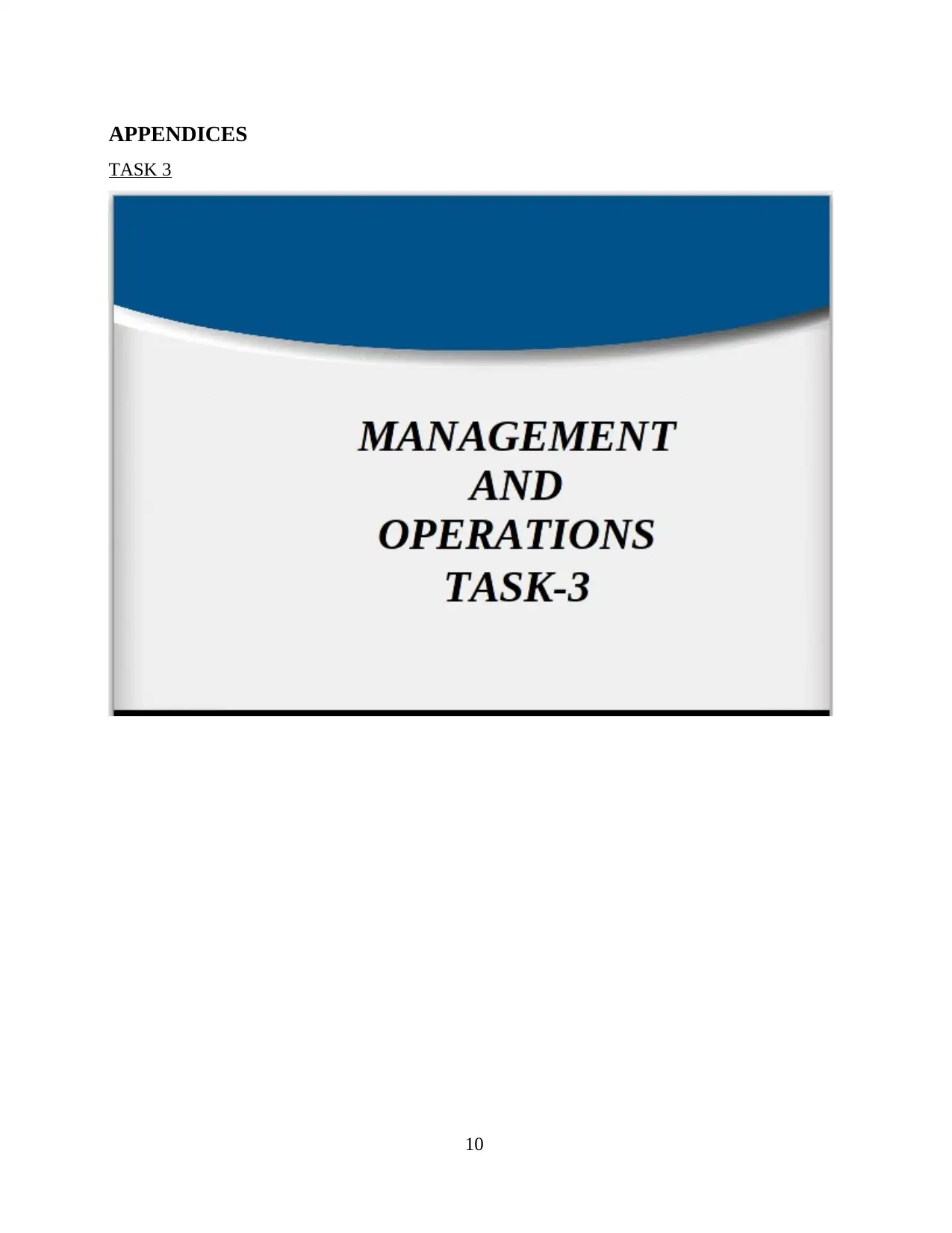
APPENDICES
TASK 3
10
TASK 3
10
⊘ This is a preview!⊘
Do you want full access?
Subscribe today to unlock all pages.

Trusted by 1+ million students worldwide
1 out of 31
Related Documents
Your All-in-One AI-Powered Toolkit for Academic Success.
+13062052269
info@desklib.com
Available 24*7 on WhatsApp / Email
![[object Object]](/_next/static/media/star-bottom.7253800d.svg)
Unlock your academic potential
Copyright © 2020–2025 A2Z Services. All Rights Reserved. Developed and managed by ZUCOL.





